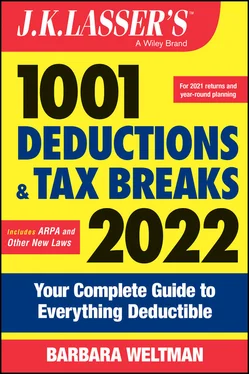Barbara Weltman - J.K. Lasser's 1001 Deductions and Tax Breaks 2022
Здесь есть возможность читать онлайн «Barbara Weltman - J.K. Lasser's 1001 Deductions and Tax Breaks 2022» — ознакомительный отрывок электронной книги совершенно бесплатно, а после прочтения отрывка купить полную версию. В некоторых случаях можно слушать аудио, скачать через торрент в формате fb2 и присутствует краткое содержание. Жанр: unrecognised, на английском языке. Описание произведения, (предисловие) а так же отзывы посетителей доступны на портале библиотеки ЛибКат.
- Название:J.K. Lasser's 1001 Deductions and Tax Breaks 2022
- Автор:
- Жанр:
- Год:неизвестен
- ISBN:нет данных
- Рейтинг книги:3 / 5. Голосов: 1
-
Избранное:Добавить в избранное
- Отзывы:
-
Ваша оценка:
- 60
- 1
- 2
- 3
- 4
- 5
J.K. Lasser's 1001 Deductions and Tax Breaks 2022: краткое содержание, описание и аннотация
Предлагаем к чтению аннотацию, описание, краткое содержание или предисловие (зависит от того, что написал сам автор книги «J.K. Lasser's 1001 Deductions and Tax Breaks 2022»). Если вы не нашли необходимую информацию о книге — напишите в комментариях, мы постараемся отыскать её.
J.K. Lasser's 1001 Deductions and Tax Breaks 2022: Your Complete Guide to Everything Deductible
1001 Deductions and Tax Breaks, 2022
J.K. Lasser's 1001 Deductions and Tax Breaks 2022 — читать онлайн ознакомительный отрывок
Ниже представлен текст книги, разбитый по страницам. Система сохранения места последней прочитанной страницы, позволяет с удобством читать онлайн бесплатно книгу «J.K. Lasser's 1001 Deductions and Tax Breaks 2022», без необходимости каждый раз заново искать на чём Вы остановились. Поставьте закладку, и сможете в любой момент перейти на страницу, на которой закончили чтение.
Интервал:
Закладка:
Qualifying Child
The following is a brief explanation of a qualifying child and a qualifying relative (someone who is not a qualifying child):
A qualifying child must meet all of the following conditions:
Relationship test: The child must be your son or daughter (natural, adopted, step, and in some cases foster) or a descendant of your sibling (e.g., niece or nephew).
Age test: The child must be younger than you and either younger than 19 years old, be a “student” younger than 24 years old as of the end of the calendar year, or any age but permanently and totally disabled.
Residency test: The child must live with you in the United States for more than half the year (special rules for noncustodial parents are explained later).
Joint return test: The child cannot file a joint return unless doing so to claim a tax refund.
Support test: The child does not provide more than half of his or her own support.
Multiple people claiming the child as a dependent.Where one parent has physical custody of the child, he or she can waive treating the child as a dependent to permit the noncustodial parent to do so. The waiver (annually or permanently) is made on Form 8332, Release/Revocation of Release of Claim to Exemption for Child by Custodial Parent . The form applies to some benefits (e.g., child tax credit) but not for other benefits (e.g., earned income tax credit, dependent care credit, head of household status).
Where 2 people are eligible to treat the child as a dependent, a “tie breaker rule” comes into play. Generally, the person with greater physical custody (determined by counting the nights that the child spends with each person) is determinative. However, when there's an even split, other rules are used to decide which person can treat the child as a dependent.
Qualifying Relative
This is a person who is not a qualifying child and who meets all of the following conditions:
Relationship test. The person must be either related to you in a stated way (e.g., a child too old to be a qualifying child, grandchild, parent, certain in‐laws, aunt, uncle, niece, or nephew) or a member of your household.
Support test. You must provide more than half of the person's support for the year.
Gross income test. The person must have a gross income below a set amount ($4,300 in 2021).
Child Tax Credit
The U.S. Department of Agriculture estimates that it costs a middle‐class family over $233,610 to raise a child born in 2015 to age 18 (there are no newer statistics), but if you factor in inflation, the cost becomes $261,473). In recognition of this cost, the tax law allows you to claim a tax credit.
Benefit
You may claim a tax credit of up to $3,600 for a qualifying child from birth to under age 6 and $3,000 for age 6 but under 18. You may claim a $500 credit for a qualifying dependent (a person who is not a qualifying child). If the credit for a qualifying child that you are entitled to claim is more than your tax liability, you may be entitled to a refund under certain conditions.
The credit for a qualifying child is fully refundable if you (or your spouse if married filing jointly) meet certain conditions; the credit for a qualifying dependent is not refundable. From July 1, 2021, through December 31, 2021, the IRS paid one‐half of the credit on an advanced basis (ratably each month) to you if you were eligible for the credit, unless you opted to forego the advance payments. These payments are reported to you on IRS Letter 6419 (sent in January 2022). The balance of the credit is claimed on your 2021 income tax return.
The advance payments were based on information the IRS had about you for 2020 (your income, dependents, filing status, residency). If there have been changes, you may have to repay any excess credit amounts you received (see Pitfalls ).
Conditions
To claim the child tax credit, you must meet 2 conditions:
1 You must have a qualifying child or a qualifying dependent with a valid Social Security number.
2 Your income must be below a set amount. To have the credit treated as refundable, you must meet a residency test. This means you (or your spouse if married filing jointly) have a principal place of abode in the U.S. for more than half of 2021 or are a bona fide resident of Puerto Rico for 2021.
QUALIFYING CHILD
You can claim the credit only for a “qualifying child.” There are 5 tests for a qualifying child and you must meet all of them. A qualifying child who meets the 5 tests:
1 Age test. The child must be under age 18 by the end of the 2021. This age limit applies even if a child is disabled (but such an older child may be a qualifying dependent explained later).
2 Residence test. The child must have the same principal residence as you for more than half the tax year. There are some exceptions in certain cases for a child of divorced or separated parents, a kidnapped child, temporary absences, and for a child who is born or dies during the year.
3 Support test. The child does not provide more than half of his or her support.
4 Social Security number. No credit is allowed unless the child has a Social Security number. The Social Security number must be issued on or before the due date of your return. A Social Security card that is labeled “not valid for employment” (i.e., it is only good for purposes of receiving federal benefits, such as Medicaid) is not treated as a valid Social Security number for purposes of the child tax credit.
5 Nationality. The child must be a U.S. citizen or national, or a resident of the United States. The person can't be a resident of Canada or Mexico.
QUALIFYING DEPENDENT
You may claim the $500 nonrefundable child tax credit for a qualifying dependent. A “qualifying dependent” is a person who is not a qualifying child and who is viewed as a dependent (even though there is no dependency exemption). More specifically, a dependent is a qualifying relative. There are 5 tests for being a qualifying relative, all of which must be met:
1 Relationship test. The person must be your child (including adopted or step); your grandchild or great‐grandchild; in‐law (son, daughter, father, mother, brother, or sister); parent or stepparent; sibling (including step and half); and aunt, uncle, niece, or nephew if related by blood.
2 Gross income test. For 2021, this means having gross income exceeding $4,300.
3 Support test. You must provide more than half of the person's support for the year.
4 Qualifying child test. The person cannot be a qualifying child for you or any other taxpayer.
5 Residency test. The qualifying dependent must be a U.S. citizen, national, or resident of the United States. The person can't be a resident of Canada or Mexico.
MAGI LIMIT
You must have modified adjusted gross income (MAGI) below a set amount. The credit you are otherwise entitled to claim is reduced or eliminated if your MAGI exceeds a set amount. MAGI for purposes of the child tax credit means AGI increased by the foreign earned income exclusion, the foreign housing exclusion or deduction, or the possession exclusion for American Samoa residents.
The credit phases out in 2 stages: first for the amount above $2,000 and then for the remaining $2,000. The credit amount above $2,000 is reduced by $50 for each $1,000 of MAGI or a fraction thereof over the MAGI limit for your filing status. The phaseout begins if MAGI exceeds the limits found in Table 1.1. The remaining $2,000 credit phaseout limits are in Table 1.2.
Example
Интервал:
Закладка:
Похожие книги на «J.K. Lasser's 1001 Deductions and Tax Breaks 2022»
Представляем Вашему вниманию похожие книги на «J.K. Lasser's 1001 Deductions and Tax Breaks 2022» списком для выбора. Мы отобрали схожую по названию и смыслу литературу в надежде предоставить читателям больше вариантов отыскать новые, интересные, ещё непрочитанные произведения.
Обсуждение, отзывы о книге «J.K. Lasser's 1001 Deductions and Tax Breaks 2022» и просто собственные мнения читателей. Оставьте ваши комментарии, напишите, что Вы думаете о произведении, его смысле или главных героях. Укажите что конкретно понравилось, а что нет, и почему Вы так считаете.












